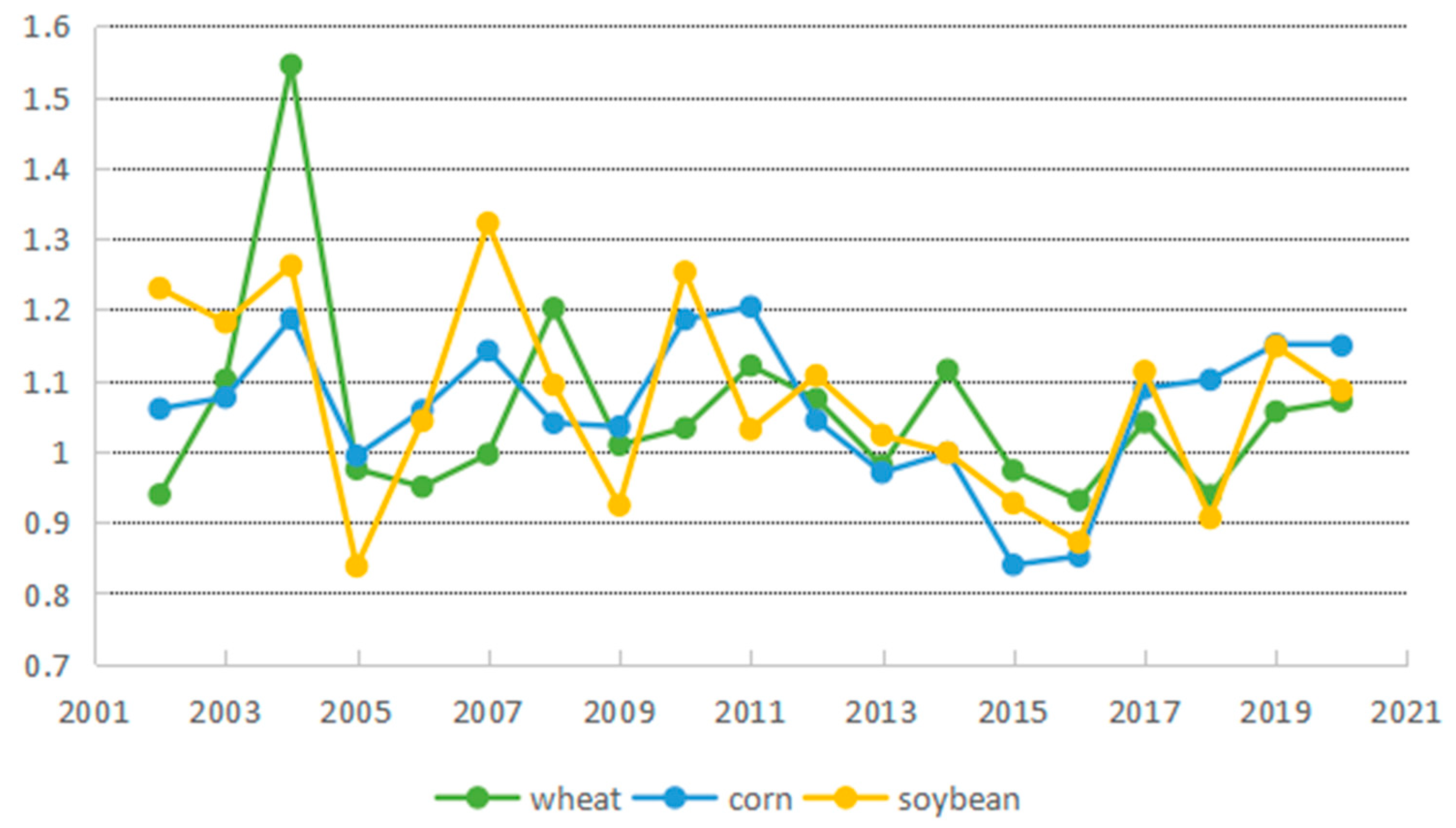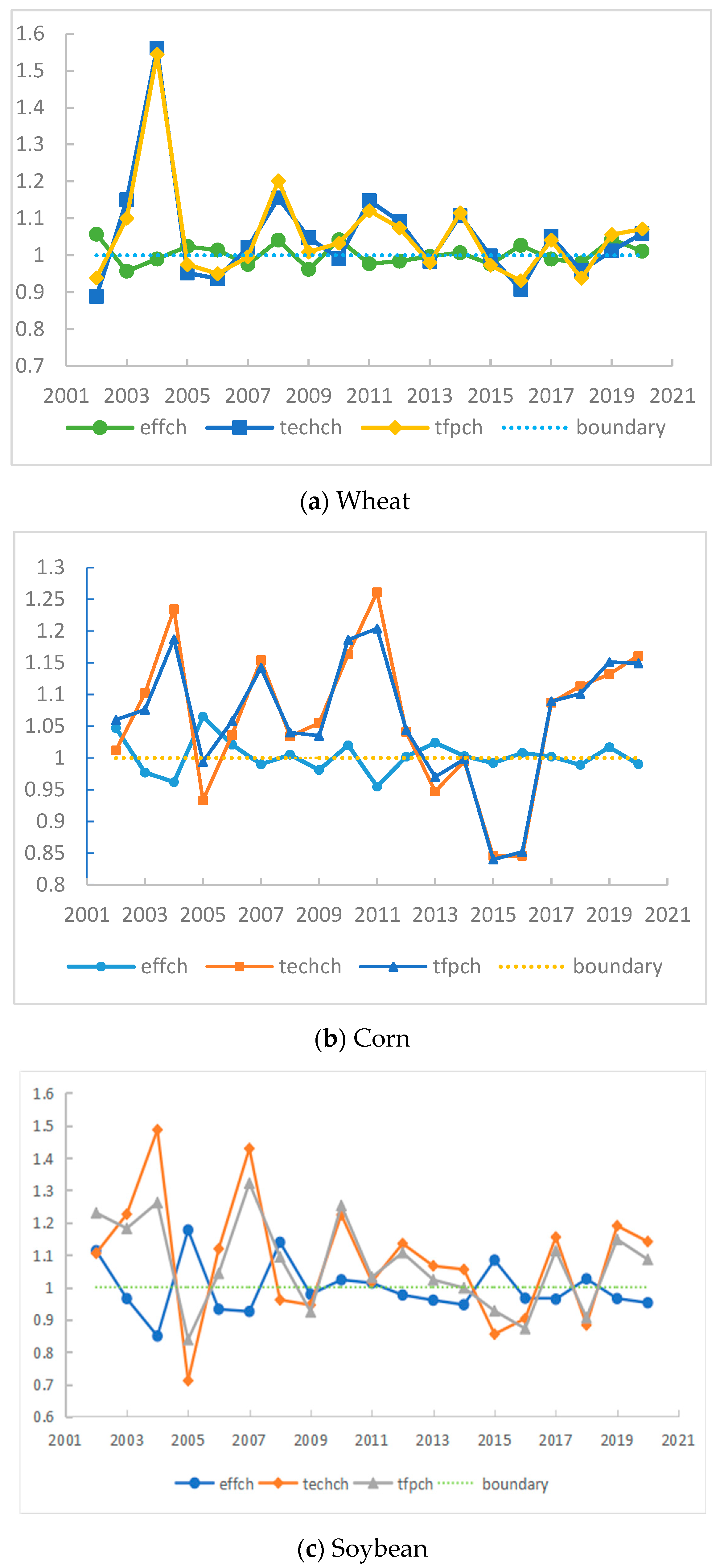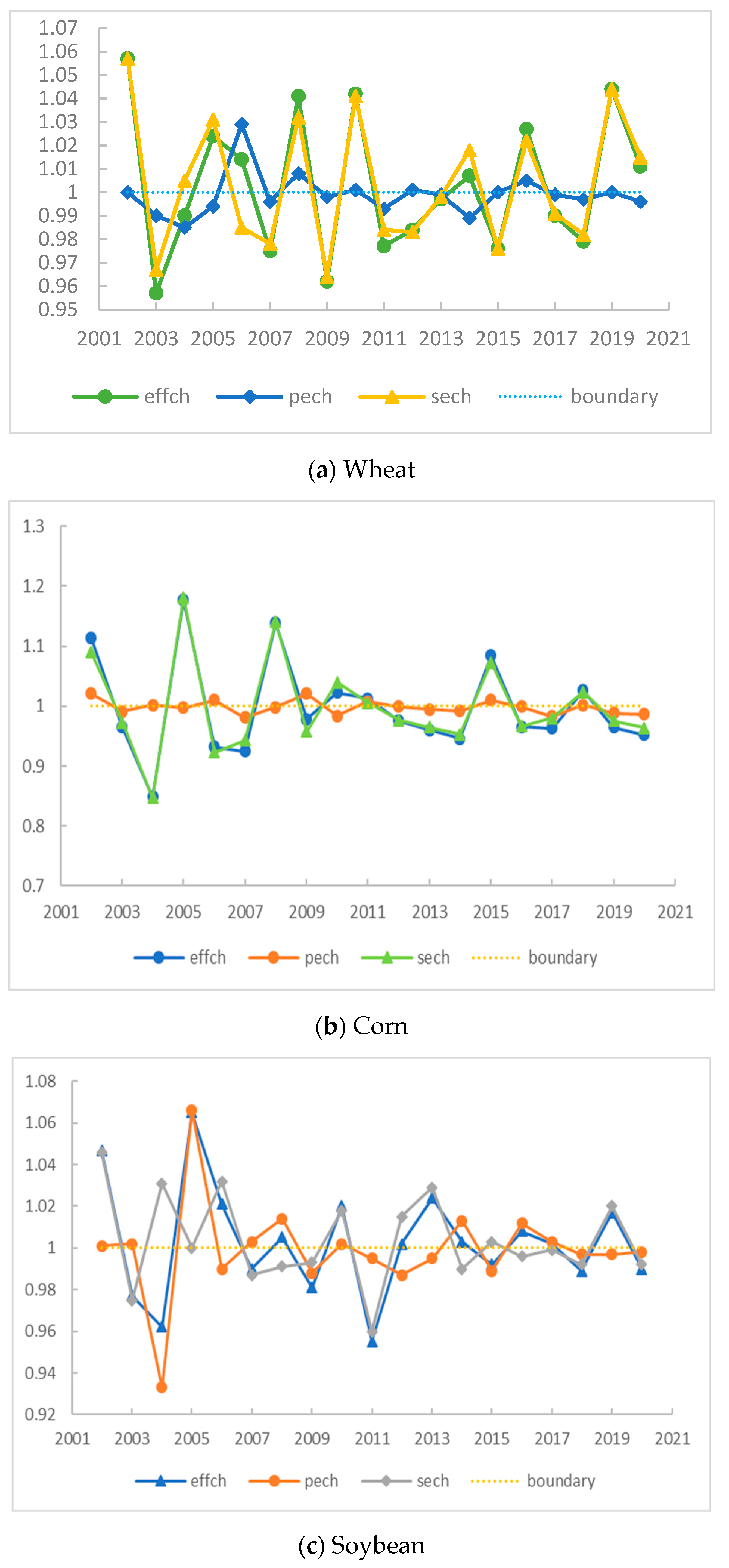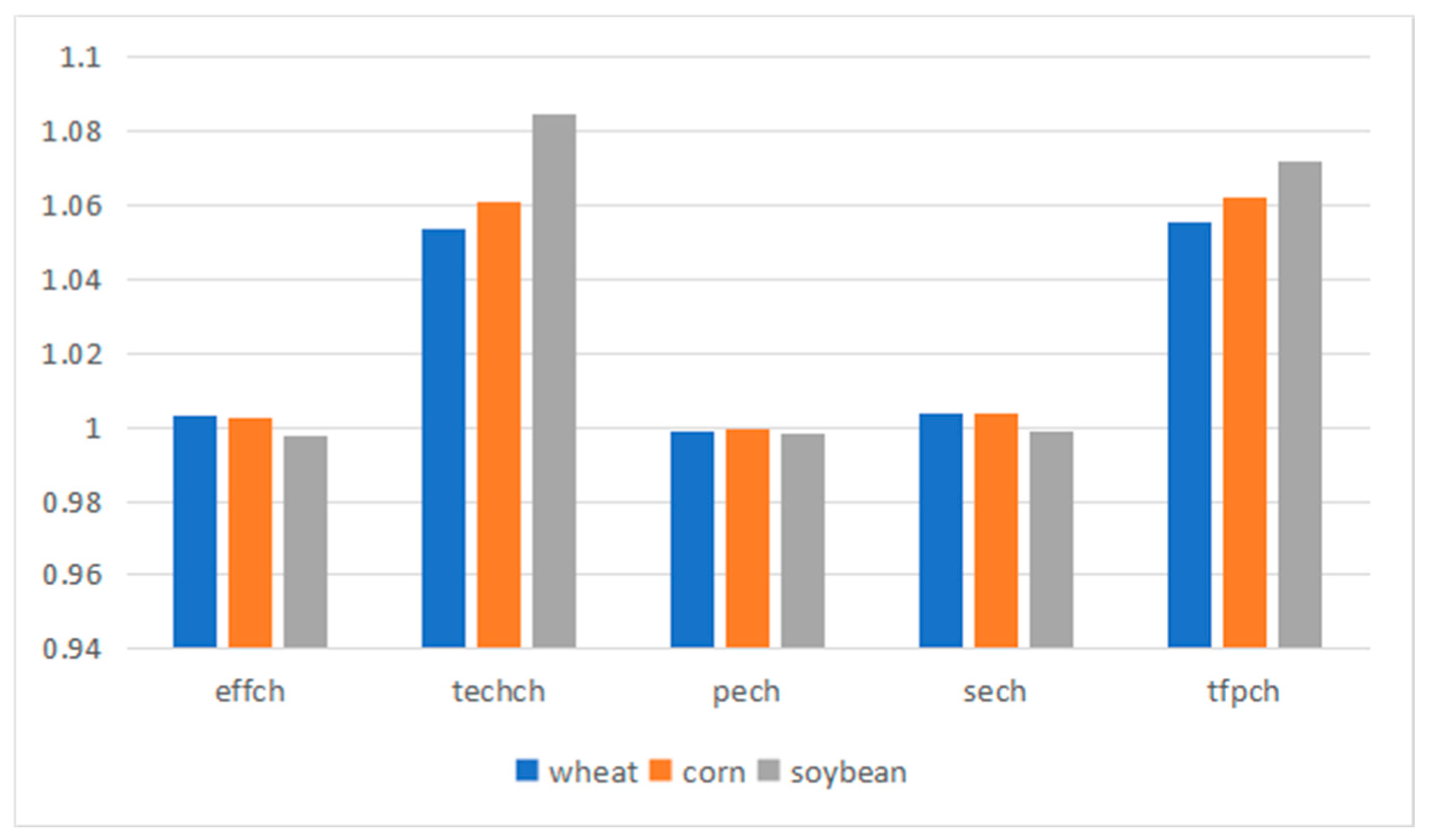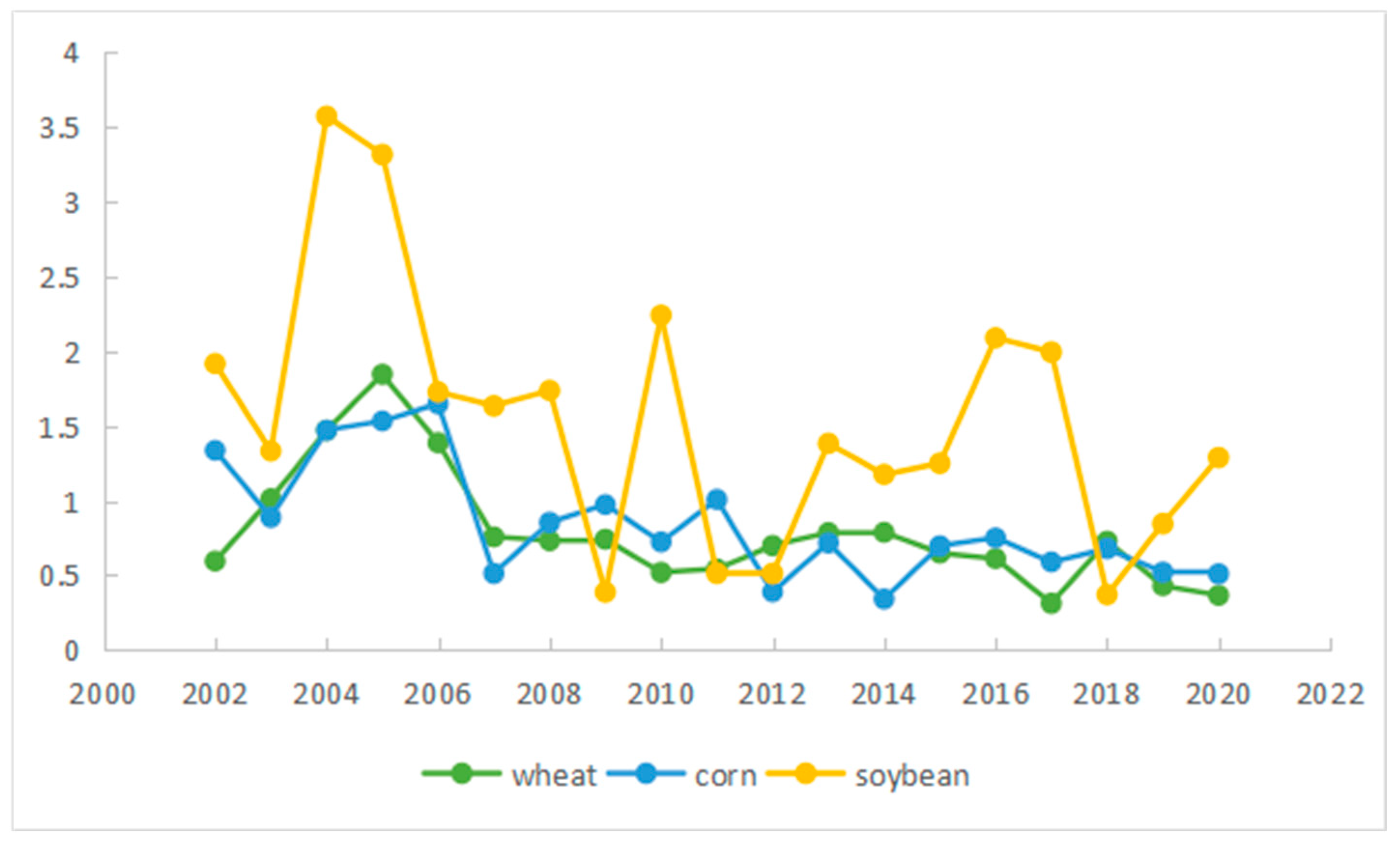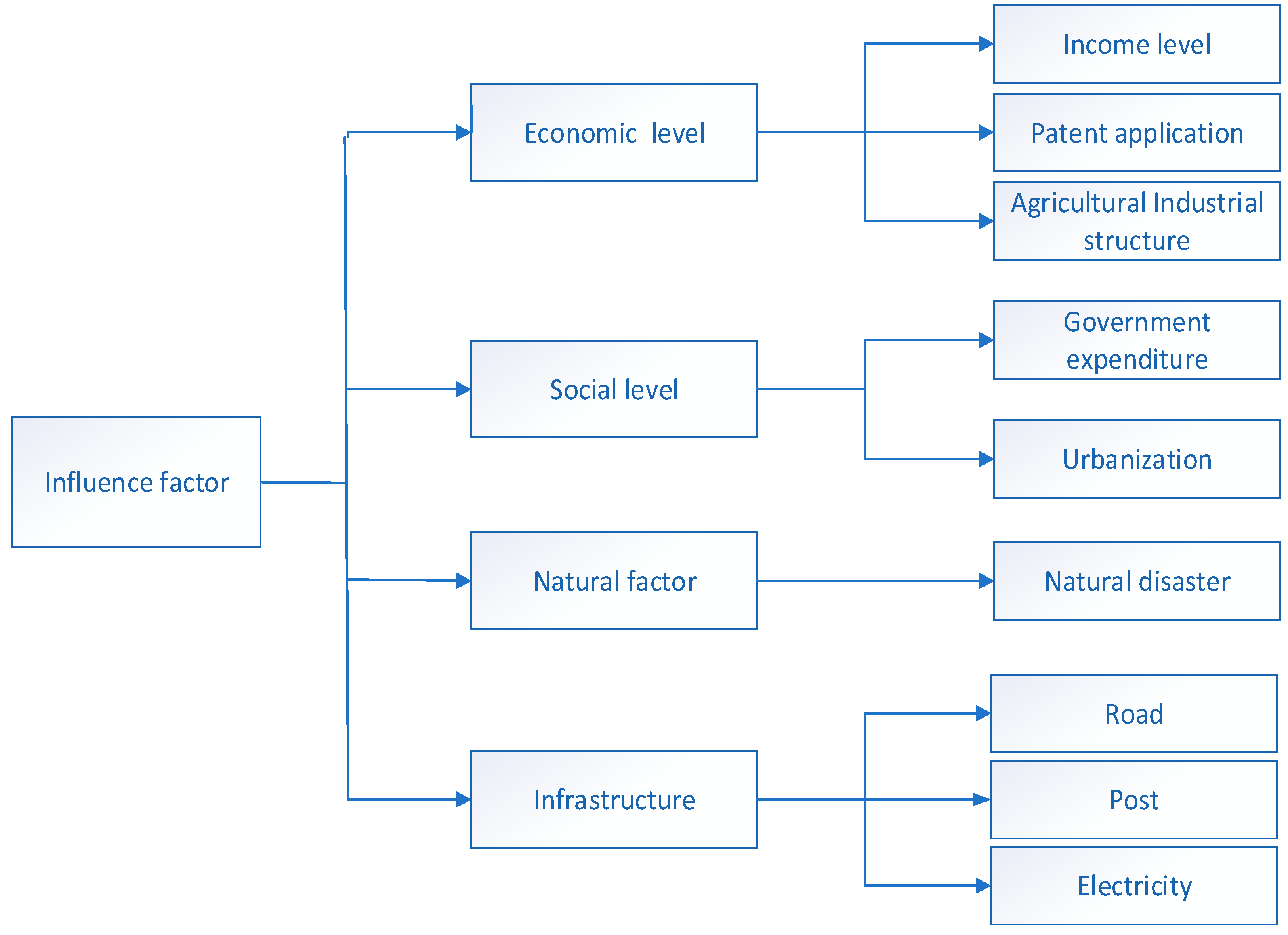1. Introduction
River basins have played a pivotal role in human civilization’s history [
1]. Favorable natural features make river basins vital for agriculture. The Yellow River Basin is of paramount importance to China’s agricultural sector [
2]. Despite accounting for merely 2% of China’s river discharge, it sustains 12% of the population and irrigates 15% of the nation’s cultivable land. In 2022, the production of wheat, corn, and soybeans accounted for 20.06%, 40.38%, and 2.95% of China’s total food crop output, respectively. The Yellow River Basin is recognized as a major food-producing area in China, with a total food crop output of 243 million tons in 2022, accounting for 35.33% of the national total. Among these, the contribution rates of corn, wheat and soybeans to China’s crop output were 42%, 57.12%, and 27.98%, respectively [
3]. In the Yellow River Basin, the sowing area of corn, wheat, and soybeans ranks in the top three. China is the largest soybean consumer in the world and also regards soybeans as important food crops [
4,
5]. Since the onset of the twenty-first century, the increased frequency of natural disasters has markedly impacted food security and production. The food crisis precipitated by the Russo-Ukrainian conflict has heightened scientific concern regarding food production and security. This geopolitical conflict has not only disrupted food supply chains but has also highlighted the critical need for enhancing the productivity of grain crops to mitigate the risks posed by both natural and man-made crises. In this context, this paper aims to assess the Total Factor Productivity (TFP) of food crops within the Yellow River Basin and to examine its determinants. The objective is to identify effective strategies for enhancing the productivity of food crops and ensuring food security.
Scholars have extensively researched agricultural productivity. Several scholars have concentrated on assessing Total Factor Productivity (TFP) in agriculture [
6,
7,
8,
9], thereby investigating methods to enhance productivity [
10,
11]. Scholars have also comprehensively analyzed agricultural TFP in different countries, such as the United States [
10], Pakistan [
12], and Africa [
13], among others. Additionally, a substantial body of research has delved into the factors influencing agricultural production (inputs), including the efficiency of water resources [
14,
15] and the efficiency or value of agricultural land utilization [
16,
17]. Scholarly research on crop TFP has primarily concentrated on the impacts of policy changes, revealing significant potential for productivity growth through market liberalization and technological progress [
18]. However, these studies, focusing on specific crops like wheat in China [
19] and rice in India [
20], highlight a notable gap in the literature: a lack of comprehensive, cross-sectional analysis comparing TFP across various crop types. On the other hand, some studies have extensively explored agricultural production and crop cultivation across various river basins, highlighting key areas such as irrigation demands, conservation tillage impacts, and factors affecting crop productivity. Studies have been conducted in diverse settings, including the Niger River Basin [
21], Ohio River Basin [
22], Indus Basin [
23], Maipo River Basin [
24], Lower Mekong River Basin [
25], Vu Gia Thu Bon River Basin [
26], Nile Basin [
27], Yangtze River Basin [
28], Poyang Lake Basin [
29], and Lower Mekong River Basin [
30], focusing on the optimization of water use, technological advancements, and the management of environmental challenges to enhance agricultural efficiency and sustainability.
A limited number of researchers have also investigated the efficiency of resource utilization in agricultural production and Total Factor Productivity (TFP) within the Yellow River Basin. For instance, Cai et al. [
31] analyzed the water productivity (WP) of maize, wheat, rice, and soybean in the basin, finding that irrigated maize and soybean yields surpassed those of rainfed crops, albeit with slightly lower water productivity (WPI) compared to rainfed crops (WPR). Zhao et al. [
32] employed a non-parametric SBM-DEA model to evaluate the water use efficiency in industry and agriculture in the middle and lower Yellow River Basin, concluding that agricultural water use efficiency exceeded that of industrial sectors. Moreover, urbanization negatively impacted the enhancement of agricultural water use efficiency. Li et al. [
33] focused on double-season maize in the Huanghuaihai Basin, assessing its yield and resource use efficiency between 2009 and 2010. Furthermore, Li et al. [
34] utilized a stochastic frontier production function to explore the evolution and drivers of agricultural TFP in the middle and upper Yellow River Basin from 1980 to 1999, discovering a 1.6-fold increase in agricultural TFP. They noted that agricultural production growth between 1980 and 1985 was primarily attributed to TFP advancements, whereas the period from 1985 to 1999 saw growth predominantly driven by input factors. The findings suggest that sustainable agricultural production growth in the Yellow River Basin hinges on technological advancement and efficiency improvements.
Existing research on agricultural TFP and its influencing factors has established a solid theoretical foundation and provided a wealth of empirical evidence across various research areas, subjects, and methodologies. However, gaps remain in the literature, particularly in the context of the Yellow River Basin in China. Firstly, previous studies have predominantly focused on agricultural TFP in river basins such as the Ohio, Indus, Mekong, and Nile, with limited attention to the Yellow River Basin, especially concerning food crops. Secondly, there is a lack of comprehensive analysis comparing the evolution of TFP across different crops, as most studies concentrate on a single type of crop like wheat or rice. Lastly, while some research measures agricultural TFP, it often does not delve into a thorough examination of the underlying drivers. Addressing these gaps, our study aims to analyze the time-series growth, spatial distribution, and determinants of TFP differences in wheat, maize, and soybean in the Yellow River Basin, utilizing panel data from nine provinces and autonomous regions from 2001 to 2020. We also investigate the drivers of TFP for these crops by considering indicators across economic, social, natural, and agricultural infrastructure dimensions, thereby offering policy recommendations to enhance food productivity and promote sustainable agricultural development.
The contributions of this paper are threefold. Firstly, it extends the scope of agricultural TFP research to the Yellow River Basin, providing a novel empirical analysis of TFP for wheat, maize, and soybean, which are crucial for national food security. Secondly, by employing the DEA-Malmquist index method, this study not only measures the TFP of these crops but also decomposes it into indices to identify the main drivers of TFP changes, highlighting the role of technological progress and the need for further improvement in the diffusion and application of new technology. Lastly, through a comprehensive analysis of the drivers of TFP from multiple dimensions, this paper offers targeted policy recommendations aimed at improving food productivity and ensuring the sustainable development of agriculture in the Yellow River Basin. These contributions not only fill the existing gaps in the literature but also provide a basis for future research and policy formulation in the context of agricultural productivity and sustainability.
The remainder of the paper is organized as follows:
Section 2 outlines the DEA-Malmquist index research methodology, encompassing model development and data processing.
Section 3 presents the measurement and decomposition of Total Factor Productivity (TFP) for food crops in the Yellow River Basin.
Section 4 examines the determinants behind TFP changes for crops in the basin.
Section 5 concludes with a summary and policy implications.
3. Measurement and Decomposition of TFP for Food Crops in the Yellow River Basin
The objective of this section is to evaluate the change rate of wheat, maize, and soybean TFP and their decomposition indices across the provinces (districts) of the Yellow River Basin, facilitating a comparison and analysis of the temporal and spatial variations in TFP for these crops. The MaxDEA Pro 6.3 was used to estimate the TFP of the three food crops.
Figure 2 displays the trend of the average TFP growth rate for the three food crops in the Yellow River Basin from 2001 to 2020. Overall, since the onset of the 21st century, the TFP fluctuations of wheat, corn, and soybean have been pronounced, with roughly three distinct phases identifiable.
Phase I (2001–2009) is characterized by significant volatility. This era exhibited greater fluctuations compared to subsequent periods. Notably, TFP for all three crops experienced substantial increases during 2003–2004, with wheat’s average annual growth rate reaching a peak of 54.5%. This surge is closely associated with the State Council’s initiation of agricultural tax reductions to support agriculture. By exempting agricultural taxes, the financial burden on farmers was reduced by approximately CNY 50 billion, benefiting nearly 800 million farmers by 2005. This policy not only stimulated farmers’ enthusiasm but also facilitated the adoption of advanced technologies, enhanced agricultural production scale, and contributed to the rise in agricultural TFP. Moreover, the legal formalization of the agricultural tax exemption policy by the end of 2005 likely played a pivotal role in the continuous improvement of corn and soybean TFP over 2005, transitioning from negative to positive growth. The intrinsic logic behind the improvement of agricultural TFP following China’s abolition of the agricultural tax lies in alleviating farmers’ financial burdens, increasing their disposable income and investment capacity. This facilitated greater investment in agricultural inputs and the adoption of more efficient farming practices, thereby enhancing overall agricultural productivity [
44]. Additionally, the policy encouraged agricultural innovation and modernization, boosting competitiveness and sustainability through the adoption of technology and improved production methods.
Phase II (2010–2016) witnessed a fluctuating decline. The Malmquist index for the three crops generally exhibited a downward trend, dipping below 1 during 2012–2013, indicating a shift from positive to negative growth, reflecting a regressive state. This downturn could be attributed to the overexpansion of production by farmers, driven by prior TFP growth and increased income, which resulted in diminished scale efficiency.
Phase III (2017–2020) marks a period of gradual recovery. Despite a decline in wheat and soybean TFP growth during 2017–2018, the overall TFP for the three crops post-2016 demonstrated a fluctuating upward trend. By 2020, the average annual growth rate of corn TFP reached 14.9%, with wheat and soybean TFP maintaining a growth rate exceeding 7% during this period.
To delve deeper into the temporal and causal dynamics of wheat, corn, and soybean TFP changes in the Yellow River Basin from 2001 to 2020, line graphs depicting the decomposition trends of TFP changes for the three crops were generated, as illustrated in
Figure 3. Generally, the trends of TFP and technological progress (tech) curves for wheat, corn, and soybean largely coincide, with tech surpassing efficiency change (
effch) in most years. This indicates that the productivity growth of these crops since the 21st century has been predominantly driven by technological advancements. Furthermore, the growth in
effch and total factor productivity change (
tfpch) is not entirely synchronous, with trends tending towards stabilization, indicating a relatively lagging overall development level. This suggests that efficiency changes in wheat, corn, and soybean are minimal and contribute less to productivity growth, highlighting the need for provinces in the Yellow River Basin to not only enhance the exploration and optimization of planting technologies and cultivation patterns for these crops but also to focus on improving technical efficiency.
Figure 4 presents the decomposition results of technical efficiency changes for wheat, corn, and soybean. Overall, the trends and amplitudes of fluctuations in scale efficiency change (sech) and effch for the three crops are highly consistent. The trend of pure technical efficiency change (pech) largely aligns with effch, albeit with significantly different fluctuation amplitudes. This suggests that the primary driver of effch improvements lies in the enhancement of sech, which exerts a more substantial influence on effch.
To facilitate a horizontal comparison of TFP and its decomposition indices across different crops, this study constructs histograms depicting the decomposition of TFP changes for three grain crops, with the findings presented in
Figure 5. On average, soybean TFP exhibits the highest annual growth rate at 6.3%, followed by maize TFP at 5.7%, and wheat TFP at 4.8%. This indicates that soybeans contribute most significantly to the enhancement of agricultural TFP in the Yellow River Basin. In terms of the TFP change decomposition indices, the technological progress (tech) index for all three crops surpasses the efficiency change (effch) index, with the growth of the tech index exceeding 5%. This underscores that the advancement of crop TFP in the Yellow River Basin is predominantly driven by technological progress. Among these, soybeans demonstrate the most rapid technological advancements, with maize and wheat trailing respectively. Moving forward, it is imperative to focus on improving technological efficiency alongside sustaining technological progress momentum to unlock the full TFP growth potential of these three crops.
In order to further study the inter-provincial differences in
TFP of the three food crops in the Yellow River Basin, the
RDI (Regional Disparity Index) index was constructed to measure the inter-provincial variations in
TFP of wheat, maize and soybean, respectively. Referring to Robiani et al. [
45] and Gluschenko [
46], the
RDI is constructed as follows:
is the TFP of the jth crop in the i-th province in year t, i =1, …, 9; j = 1, 2, 3 (wheat, corn, soybean, respectively); t = 1, …, 20. represents the average value of TFP of the j-th crop in the year t in 9 provinces. n represents the total number of the provinces along the Yellow River Basin, n = 9. In addition, 0 ≤ RDI ≤ 10, and the larger value of RDI represents the larger degree of difference.
Figure 6 reveals that among the provinces in the Yellow River Basin, the variance in soybean TFP is the most pronounced. The Regional Disparity Index (
RDI) for soybeans generally exceeds that of wheat and maize, except in the years 2009, 2011, 2012, and 2018, where it falls below. This suggests a more marked regional heterogeneity for soybeans within the basin. For wheat, the inter-provincial TFP disparities exhibit a pattern of initial increase followed by a gradual decrease. The year 2005 witnessed the highest discrepancy, with an
RDI of 1.84, whereas 2017 recorded the smallest difference, at 0.31. In comparison, maize displayed a relatively larger inter-provincial variance with more pronounced fluctuations, yet followed a similar trend of initial increase before stabilizing and then decreasing.
Specifically for soybeans, the inter-provincial TFP disparities were most significant in 2004 and 2005, with the RDI peaking at 3.57. This period coincides with China’s transition from a soybean exporter to an importer and the deepening of its international trade in 2004, which likely spurred technological advancements in soybean cultivation in certain provinces within the basin. Additionally, the RDI for soybeans was notably higher in 2010 and 2016, indicating a period of slow TFP improvement in certain provinces and low regional coordination. It is essential to focus on enhancing soybean production efficiency in these provinces to reduce the inter-provincial gap and foster coordinated regional TFP development.
4. Analysis of the Drivers of TFP Changes
This section investigates the determinants of crop TFP in the Yellow River Basin, identifying a range of dependent variables that influence TFP changes. These variables predominantly encompass economic development levels, social factors, natural conditions, and infrastructure development pertinent to agriculture. From these categories, this study initially selects nine explanatory variables for analysis: annual per capita gross regional product, agricultural industry structure, number of patents applied for and granted, government spending on agriculture, forestry, and water affairs, urbanization level, highway development level, annual rural electricity consumption, and per capita postal and telecommunications services.
Given the distinct production conditions and characteristics of wheat, corn, and soybeans, the drivers influencing TFP vary among these crops. Consequently, the explanatory variables incorporated into each crop’s TFP equation differ. Subsequently, this study conducts a Hausman test on the panel data, with the results indicating that the fixed-effects model’s estimates are unbiased. Therefore, this study employs a fixed-effects model to analyze the data. The econometric model constructed for this purpose is outlined as follows:
represents the i-th province and represents the time. is the explanatory variable, that is, the change in TFP for wheat, corn, and soybeans (tfpch) derived from Equation (8) above. is the parameter to be estimated, ; is the randomized disturbance term; and denote individual and time effects, respectively.
4.1. Data Sources and Description
This section delineates the explanatory variables across four dimensions: economic, social, natural, and agricultural infrastructure. To mitigate heteroscedasticity and diminish magnitude, certain data were transformed logarithmically. The variables are detailed as follows:
4.1.1. The Level of Economic Development
(i) Annual per capita gross regional product (lnGDP) is pivotal in agricultural TFP, potentially exerting dual effects. Firstly, the effect of technological progress (+) indicates the following: in the realm of economic development, it is widely acknowledged that advancements in this area can significantly contribute to the enhancement of TFP. This phenomenon can be attributed to the continuous accumulation of physical capital as the level of economic development ascends. With the availability of increased capital, there is a greater capacity for investment in scientific and technological research and innovation. Empirical evidence from the existing literature further substantiates this relationship, demonstrating that technological inputs exert a statistically significant impact on TFP [
47,
48]. Secondly, the structural and income effect (−) emerges as economic development escalates, leading to an enhanced industrial structure where the service sector expands more rapidly than agriculture. This shift prompts agricultural technicians to increasingly migrate to the service industry, resulting in a depletion of agricultural expertise. Such a transition is detrimental to the enhancement of agricultural TFP. Furthermore, as farmers’ net per capita income rises, their dependence on agricultural production for income augmentation diminishes. This reduction in reliance may lead to a decreased focus on improving agricultural TFP, adversely affecting the annual per capita regional GDP.
(ii) Agricultural industry structure (plant) is represented by the proportion of total agricultural output value within the combined output value of agriculture, forestry, animal husbandry, and fisheries. This metric signifies the structural shifts among various agricultural sectors, where an increase suggests a reallocation of production factors from lower to higher productivity sectors, theoretically benefiting agricultural TFP growth.
(iii) Number of patent applications granted (lnpatent) serves as an indicator of the level of agricultural innovation, reflecting enhancements in cultivation techniques, irrigation, harvesting technologies, and production methodologies. Given the cessation of authorized patent application data feedback from the Shandong Province Statistics Bureau since 2018, this study employs simple linear interpolation to compensate for this gap.
4.1.2. Social Factors
(i) Government expenditure on agriculture, forestry, and water affairs (gov). Rada et al. [
49] highlighted the significant role of fiscal spending on agriculture in enhancing regional factor productivity, as evidenced in India. The findings underscored that investment in agricultural research through government expenditure markedly boosts agricultural productivity. Similarly, Rahman and Salim [
50] employed the Fare–Primont index to assess the agricultural TFP index across 17 districts in Bangladesh, revealing that government spending on agriculture, particularly in fostering R&D and extension services, effectively elevates TFP. To neutralize the impact of price level variations, government expenditures on agriculture, forestry, and water affairs were adjusted using the respective provincial price index (2001 = 100).
(ii) Level of urbanization (urban). The urban population’s percentage of the total population serves as a measure of urbanization. In recent years, China has experienced a rising urbanization rate, marked by a significant migration of the rural populace to urban areas. This shift has resulted in a relative increase in the proportion of elderly, infirm, and disabled individuals in rural regions. Such rural population outflows potentially hinder agricultural TFP growth. Additionally, urbanization processes have encroached on agricultural land, exacerbating the scarcity of land resources and negatively impacting crop productivity enhancement.
4.1.3. Natural Factors
(i) Natural disasters (disaster). The majority of provinces within the Yellow River Basin lie in the monsoon zone, characterized by simultaneous occurrences of rain and heat. However, this region experiences an uneven seasonal distribution of rainfall, rendering it susceptible to natural disasters such as droughts and floods. Additionally, the monsoon zone faces cold winters, increasing the risk of cold waves and frosts. Conversely, Qinghai, Gansu, and parts of Inner Mongolia are situated in the non-monsoon zone, where the arid climate poses challenges to agricultural production. The Yellow River Basin primarily contends with three major natural disasters: drought, flooding, and soil erosion. An increased frequency of these disasters adversely affects agricultural TFP. The specific formula for natural disaster (disaster) is 2 × (disaster-affected area + disaster-affected area).
4.1.4. Agricultural Infrastructure Development
(i) Road infrastructure (ROAD). Adhering to the principle “To get rich, build roads first”, China has significantly enhanced its rural infrastructure in recent years, making transportation, including roads, more accessible. This improvement has contributed to the reduction in agricultural production and transportation costs. The development level of roads is quantified by the proportion of graded road length to the total road length in each province. It is evident that the convenience of transportation is positively associated with agricultural TFP.
(ii) Annual rural electricity consumption (lnelec). Rural electricity serves as a crucial energy source for activities such as agricultural irrigation and mechanized harvesting, reflecting the level of rural development. Enhancements in rural electricity infrastructure are beneficial to agricultural TFP growth.
(iii) Per capita postal and telecommunication services (POST). The volume of postal and telecommunication services represents the communication infrastructure and is positively correlated with agricultural TFP.
The data on factors influencing agricultural TFP are sourced from the statistical yearbooks of each province, including the Statistical Database of China Economic Network and the China Statistical Yearbook. The drivers of TFP for wheat, corn, and soybean in the Yellow River Basin are illustrated in
Figure 7.
4.2. Regression Results and Analysis
In this study, Stata14 software facilitated the fixed-effects regression analysis of Equation (9), with findings presented in
Table 2. Initially, the analysis revealed that the coefficients for the impact of natural disasters (disasters) on the TFP of wheat, corn, and soybean are uniformly negative and statistically significant at the 5% confidence level. This suggests that natural disasters detrimentally affect agricultural production, thereby impeding TFP growth. Notably, soybeans experienced the most severe impact from natural disasters, with an 11% reduction in TFP.
Furthermore, the level of economic development exerts both positive and negative influences on agricultural TFP. The annual per capita regional gross domestic product (lnGDP) significantly affects wheat, corn, and soybean TFP at the 10%, 5%, and 1% levels, respectively. However, while the coefficient for wheat is positive, those for corn and soybean are negative. This discrepancy is attributed to the structural effect surpassing the effect of technical progress for corn and soybean. Specifically, the average net cost yield for corn and soybeans has declined significantly compared to wheat. For instance, in 2002, soybeans had an average net yield cost of 73.17%, corn 25.9%, and wheat −3.41%. By 2012, soybean net yield dropped to 22.25%, a 50.92% decrease over ten years, while corn decreased by 4.51% to 21.39%. Conversely, wheat’s annual yield increased to 2.56%, marking a 5.97% improvement.
This marked decline in net cost yield for soybeans and corn has accelerated labor migration to the tertiary sector and led to a brain drain from agriculture, adversely affecting agricultural TFP. Moreover, the higher average annual net cost yields for soybeans and corn indicate larger income effects. Farmers cultivating these crops have higher income levels and do not solely depend on agricultural production, potentially undervaluing increases in TFP for soybeans and corn. In 2013, the average net cost return for soybeans was 5.38%, corn 7.66%, while wheat had a negative annual return of −1.4%, indicating greater potential for technological progress in wheat TFP, as corroborated by the average TFP growth rates for the three crops depicted in
Figure 2.
Since 2012, corn and soybean TFP have experienced significant declines, more so than wheat. In years where wheat TFP increased (e.g., 2013–2014), soybean TFP saw substantial declines, with corn TFP also declining to less than 1. Additionally, the coefficients for the impact of government expenditure on agriculture, forestry, and water affairs (gov), as well as road development level (road), on wheat TFP are positive and significant at the 10% level. Conversely, the coefficient for urbanization level (urban) on wheat TFP is negative (−0.21), aligning with prior analysis that urbanization leads to an agricultural brain drain and reduces arable land, thereby constraining wheat TFP growth [
51].
Lastly, for corn and soybeans, rural annual electricity consumption (lnelec) and per capita postal and telecommunication services (POST) are significant at the 5% level, indicating that improvements in electricity and communication infrastructure positively influence corn and soybean TFP, respectively.
4.2.1. Robustness Test (I): Adjustment for Explanatory Variables
To assess the robustness of the aforementioned findings, this study modified the explanatory variables from total factor productivity change (tfpch) to technological change (tech), while still employing the fixed-effect model for parameter estimation. The outcomes of this adjustment are delineated in
Table 3.
The regression outcomes indicate that both the direction and the significance levels of the coefficients for all variables under tech closely align with those observed for tfpch. This consistency confirms the robustness of the initial regression results, underscoring their reliability. Similar to the TFP analysis, natural disasters significantly impede technological advancement in wheat, maize, and soybean. Notably, wheat is the most adversely affected, substantiated by passing the significance test. This disparity may be attributed to wheat’s relatively longer growth cycle—approximately 8 months, which is double that of maize and 1.6 times longer than that of soybean—rendering it more susceptible to natural disasters. Specifically, the Yellow River Basin experiences dry springs and cold, frosty winters, conditions detrimental to wheat cultivation. Conversely, the region encounters fewer natural disasters during summer, minimizing the impact on soybean and maize growth during their respective growing seasons.
Furthermore, the level of urbanization (urban) continues to exert a significant negative influence on the technological progress of wheat. Conversely, the annual per capita regional gross domestic product (lnGDP), expenditure on agriculture, forestry, and water affairs (gov), and the development level of roads (road) positively correlate with wheat’s technological advancement, with significant coefficients.
4.2.2. Robustness Test (II): Differential GMM Estimation
Following the Hausman test, it was determined that the explanatory variable TFP exhibits endogeneity, rendering the parameter estimates from the fixed-effects model potentially biased or inconsistent. To address this issue, this study employed the Difference Generalized Method of Moments (Difference GMM) estimation method for a second robustness test. The Difference GMM approach incorporates lagged explanatory variables into the model, serving dual purposes: firstly, to capture the inertia and persistent impact of TFP itself, acting as proxies for certain omitted variables; and secondly, to mitigate the issue of joint endogeneity, thereby significantly enhancing the robustness of the estimation results. The outcomes are presented in
Table 4. Furthermore, given that the Difference GMM estimation necessitates the exogeneity of instrumental variables, a Sargan over-identification test was conducted. The
p-values for the Sargan test for wheat, corn, and soybean are 0.7068, 0.11080, and 0.3862, respectively, all exceeding 0.1. This suggests that the chosen instrumental variables are appropriate and effectively address the model’s endogeneity problem.
The Difference GMM estimation results, after incorporating the lagged variable l.tfpch, demonstrate that the sign of the coefficients for all variables remains largely consistent with those in
Table 2. Moreover, there is a notable improvement in the significance levels, indicating that the second robustness test has been successfully passed. This further underscores the strong endogeneity of tfpch, with the inclusion of the lagged variable l.tfpch compensating for its inherent inertia and the limitations posed by omitted variables, thereby enhancing both the significance and robustness of the results. Collectively, the coefficient representing the impact of natural disasters (disasters) on the TFP of the three crops is significantly negative at the 1% level, aligning with the initial tfpch panel regression findings. Additionally, the lagged tfpch for both wheat and soybean has a significant negative effect on the current period, suggesting that TFP growth for these crops exhibits dynamic continuity. A high TFP in the preceding period limits further improvements and, due to higher incomes, reduces the incentive for intensive farming and agricultural research [
52]. Conversely, the lagged tfpch for maize shows a positive effect on the current period, though it does not pass the significance test. Specifically, a 1% point increase in expenditure on agriculture, forestry, and water affairs (gov) corresponds to a 4.49% point increase in wheat tfpch, significant at the 1% level. Regarding infrastructure, the level of roads positively influences wheat tfpch, while the level of rural electricity and communication facilities positively affects maize and soybean tfpch, respectively, all significant at the 1% level. Lastly, expenditure on agriculture, forestry, and water affairs (gov) is positively linked to soybean TFP enhancement, shifting from insignificant in
Table 2 to significant at the 10% level.
4.2.3. Robustness Test (III): System GMM Estimation
To enhance the robustness of the results, this study substitutes the test model with the System GMM (Generalized Method of Moments) for robustness checks, as depicted in
Table 5. Compared to the Difference GMM, the System GMM approach is more effective in addressing the potential issue of weak instruments in the Difference GMM estimates, thus providing more reliable results. In line with the previous analysis, this study continues to use the lagged TFP (l.tfpch) as the instrument variable to control for the potential endogeneity due to TFP’s inherent persistence. To verify the validity of the instrument variables, we conduct AR(1), AR(2), and Sargan tests. The outcomes indicate no second-order autocorrelation and no over-identification of instrument variables, confirming the appropriateness of the model specification.
Table 5 reveals that the direction and significance of the coefficients in the System GMM model regression results remain consistent, indicating robustness in the effects of the explanatory variables. Notably, natural disasters (disaster) exert a significant negative impact on wheat, corn, and soybean productivity, with a 1% significance level, aligning with prior empirical findings and observations. Additionally, the lagged TFP of wheat and soybean continues to have a significant negative influence on the current period’s TFP, as observed in the Difference GMM results, suggesting that higher growth in lagged TFP may constrain the potential for current TFP improvement. Specifically, urbanization negatively affects wheat TFP growth at a 5% significance level, likely due to the associated reduction in land area and agricultural employment. For wheat, government expenditure on agriculture and forestry (gov), road infrastructure (road), and the number of patent applications and authorizations (lnpatent) all significantly enhance TFP. For corn, the development of the electricity sector (lnelec) significantly promotes TFP improvement at a 1% significance level. For soybean, government expenditure on agriculture and forestry (gov) and per capita postal and telecommunications services (post) positively contribute to TFP enhancement. In summary, the regression results in
Table 5 withstand the third robustness check.
5. Conclusions and Policy Implications
In this study, we meticulously analyzed panel data from nine provinces within the Yellow River Basin spanning from 2001 to 2020, employing the DEA-Malmquist index to delve into the temporal characteristics, spatial distribution, and determinants of the TFP variations in wheat, corn, and soybean. Our findings reveal significant phase-wise fluctuations in the TFP growth rates of these crops, with soybean exhibiting the highest average growth rate across the basin, highlighting substantial inter-regional disparities in productivity and underscoring technological advancement as the primary catalyst for TFP enhancement. The analysis indicates that while scale efficiency improvements primarily drive technical efficiency gains, there remains a stagnation in pure technical efficiency growth. Moreover, this study elucidates the impediments posed by natural disasters to the technological progress in wheat production and delineates the positive correlation between per capita income and wheat TFP growth, juxtaposed against its negative correlation with corn and soybean TFP growth. These insights are pivotal for comprehending and augmenting agricultural productivity.
To foster sustainable agricultural development in the Yellow River Basin, a dual-drive strategy is advocated, emphasizing both technological advancement and efficiency enhancement. This entails not only the optimization of resource allocation and the promotion of new technology adoption to elevate labor productivity but also the establishment of a financial subsidy mechanism for agricultural natural disaster insurance to bolster resilience against calamities. Enhancing the coverage and participation in agricultural insurance, coupled with government-backed support in technology, human resources, and financial incentives, is crucial for improving the quality and efficiency of wheat, corn, and soybean production.
Furthermore, it is imperative to promote new water-saving agricultural technologies and bolster the construction of ancillary agricultural production facilities. Financial, fiscal, and social capital should be directed towards the development of rural infrastructure, including water, electricity, transportation, and communication systems, as well as public services such as education and healthcare. Given the arid spring climate in the Yellow River Basin, the adoption of water–fertilizer integration and high-efficiency water-saving irrigation technologies should be accelerated, alongside measures to alleviate irrigation costs and guide water-efficient planting and production practices.
This study, while achieving research findings with practical significance, also inevitably has some shortcomings. Future studies should aim for methodological innovation and a more integrated approach that combines both qualitative and quantitative analysis. Specifically, there is a need for the development and application of more consistent and applicable indices or models to accurately compare agricultural TFP across different regions. The DEA-Malmquist index, while valuable, has limitations in inter-regional comparisons that could be addressed by combining it with other methods like Meta-Frontier Analysis to overcome the drawbacks of relying on a single approach. Since the two-stage approach has some drawbacks, such as boundary problems in regression analyses and series correlation among DEA efficiency scores, we should apply more consistent inference as well [
53]. Ma [
54] and Henriques et al. [
55] pointed out the bias and inconsistency in the traditional two-stage DEA estimates, emphasizing the need for models that consider the allocation of inputs and intermediate measures more comprehensively. Jebali et al. [
56] and Wijesiri et al. [
57] applied a two-stage double bootstrap DEA approach to account for the bias and serial correlation of efficiency scores. Therefore, the improved model should be applied to the research on total factor productivity of food crops, in order to observe the bias of the empirical results in this paper.

